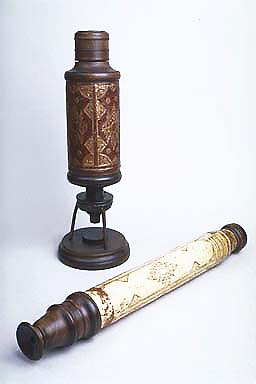A compound microscope, with a single draw tube, on a tripod stand. The outer pasteboard tube, covered with gold-tooled red leather, slides over an inner one covered with vellum. The lens mounts are lignum vitae; the base is a modern restoration. The microscope is focused by screwing it up and down in the stand. The instrument can be dated by the pattern of decorative tooling.
In the first paragraph of the preface to his book on microscopy, Micrographia (catalogue no. 26), Robert Hooke explains the value of optical instruments: ‘By the addition of such artificial Instruments and methods, there may be, in some manner, a reparation made for the mischiefs, and imperfection, mankind has drawn upon itself’, part of which stems from ‘a deriv’d corruption, innate and born with him’. He later explains the source of this inheritance and part of its remedy: ‘And as at first, mankind fell by tasting of the forbidden Tree of Knowledge, so we, their Posterity, may be in part restor’d by the same way, not only by beholding and contemplating, but by tasting too those fruits of Natural knowledge, that were never yet forbidden’.




